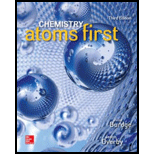
Interpretation:
It should be stated that how the given set of properties follows the trend from left to right across the period and top to bottom of the group in the periodic table.
Concept Introduction:
Periodic Table: The available chemical elements are arranged considering their
In periodic table the horizontal rows are called periods and the vertical column are called group.
The elements placed on the left of the table are metals which contain its last electron on s-orbital hence considered as s-block elements and the elements placed on the right side of the table contains its last electron in p-orbital which is regarded as p-block elements.
The s and p block elements together are called as main group elements.
The elements with its last electron in d-orbital are called d-block elements also called as
There are seven periods and 18 groups present in the table and some of those groups are given special name as follows,
Cation: Removal of electron from the atom results to form positively charged ion called cation.
Anion: Addition of electron to atom results to form negatively charged ion called anion.
The net charge present in the element denotes the presence or absence of electrons in the element.
Electronegativity: It is the tendency of the element to attract the pair of electrons towards itself.
Concept Introduction:
Shielding effect: The outermost electrons present in the element gets shielded or screened from the nuclear charge by electron present near to the nucleus that is the electrons that surrounds the nucleus (core electrons).
Effective nuclear charge: It is the total positive charge experienced by the valence electrons from the nucleus.
Atomic radius:
Atomic radius is the distance between the atomic nucleus and outermost electron of an atom. From the atomic radius, the size of atoms can be visualized. But there is no specific distance from nucleus to electron due to electron cloud around the atom does not have well-defined boundary.
Electronegativity: It is the tendency of the element to attract the pair of electrons towards itself.
Concept Introduction:
First ionization energy:
The ionization energy is the minimum energy required to remove the electron from an isolated atom which is in the gaseous state results to give gaseous ion with one positive charge.
Electronegativity: It is the tendency of the element to attract the pair of electrons towards itself.
Concept Introduction:
Acidity of oxides:
The more electronegativity the element has then the respective oxide of the element has more acidity.
Electronegativity: It is the tendency of the element to attract the pair of electrons towards itself.
Want to see the full answer?
Check out a sample textbook solution
Chapter 4 Solutions
Chemistry: Atoms First
- How can i draw the mechanisms for this molecule?arrow_forwarda. Discuss and explain he difference IN Stability between the Chai and Boat Гольцу от судомехане b. For the Following Molecule draw both possible Clain conformations and explain which one is more stable and for what Reason. H. CH₂ CH₂ H "Harrow_forwarddraw out these molecules pleasearrow_forward
- Question 5: Name the following compound in two ways using side chain and using prefix amine (Common name and IUPAC name both) CH3NH2 CH3CH2NHCH3 CH₂CH₂N(CH3)2 Draw the structure of diethyl methyl amine Question 6. Write the balanced combustion reaction for: a. Hexane b. Propyne c. 2-pentene Question 7: Write the following electrophilic substitution reactions of benzene: Hint: Use notes if you get confused a. Halogenation reaction: b. Nitration reaction : c. Sulphonation reaction: d. Alkylation reaction: e. Aceylation reaction:arrow_forwardQuestion 4. Name the following structures ○ CH3-C-N-H H CH3CH2-C-N-H H CH3CH2-C-N-CH3 Harrow_forwardA. Add Water to below compound which 2-methyl 2-butene (addition Reaction) H₂C CH₂ CH, + H₂O-> ? Major product? Minor product? B. Add Bromine to the compound which 2-methyl 2-butene (addition Reaction) CH₂ CH₂ + Br₂→ ? Major product and Minor product both are same in this? C. Add Hydrogen Bromide to the compound which 2-methyl 2-butene (addition Reaction) H,C CH₂ CH₂ + HBr Major product? Minor product? D. Add Hydrogen to the compound which 2-methyl 2-butene (addition Reaction) CH₂ CH₂ + H₂ Major product and Minor product both are same in this?arrow_forward
 ChemistryChemistryISBN:9781305957404Author:Steven S. Zumdahl, Susan A. Zumdahl, Donald J. DeCostePublisher:Cengage Learning
ChemistryChemistryISBN:9781305957404Author:Steven S. Zumdahl, Susan A. Zumdahl, Donald J. DeCostePublisher:Cengage Learning ChemistryChemistryISBN:9781259911156Author:Raymond Chang Dr., Jason Overby ProfessorPublisher:McGraw-Hill Education
ChemistryChemistryISBN:9781259911156Author:Raymond Chang Dr., Jason Overby ProfessorPublisher:McGraw-Hill Education Principles of Instrumental AnalysisChemistryISBN:9781305577213Author:Douglas A. Skoog, F. James Holler, Stanley R. CrouchPublisher:Cengage Learning
Principles of Instrumental AnalysisChemistryISBN:9781305577213Author:Douglas A. Skoog, F. James Holler, Stanley R. CrouchPublisher:Cengage Learning Organic ChemistryChemistryISBN:9780078021558Author:Janice Gorzynski Smith Dr.Publisher:McGraw-Hill Education
Organic ChemistryChemistryISBN:9780078021558Author:Janice Gorzynski Smith Dr.Publisher:McGraw-Hill Education Chemistry: Principles and ReactionsChemistryISBN:9781305079373Author:William L. Masterton, Cecile N. HurleyPublisher:Cengage Learning
Chemistry: Principles and ReactionsChemistryISBN:9781305079373Author:William L. Masterton, Cecile N. HurleyPublisher:Cengage Learning Elementary Principles of Chemical Processes, Bind...ChemistryISBN:9781118431221Author:Richard M. Felder, Ronald W. Rousseau, Lisa G. BullardPublisher:WILEY
Elementary Principles of Chemical Processes, Bind...ChemistryISBN:9781118431221Author:Richard M. Felder, Ronald W. Rousseau, Lisa G. BullardPublisher:WILEY





